Andrew Bruce Davidson
Select Format
Select Condition 
More by James Strahan
Book Overview
This is an EXACT reproduction of a book published before 1923. This IS NOT an OCR'd book with strange characters, introduced typographical errors, and jumbled words. This book may have occasional imperfections such as missing or blurred pages, poor pictures, errant marks, etc. that were either part of the original artifact, or were introduced by the scanning process. We believe this work is culturally important, and despite the imperfections, have elected to bring it back into print as part of our continuing commitment to the preservation of printed works worldwide. We appreciate your understanding of the imperfections in the preservation process, and hope you enjoy this valuable book. This description may be from another edition of this product.
Format:Hardcover
Language:English
ISBN:1359150544
ISBN13:9781359150547
Release Date:May 2016
Publisher:Palala Press
Length:358 Pages
Weight:1.49 lbs.
Dimensions:0.8" x 6.1" x 9.2"
Customer Reviews
5 customer ratings | 5 reviews
There are currently no reviews. Be the first to review this work.





































